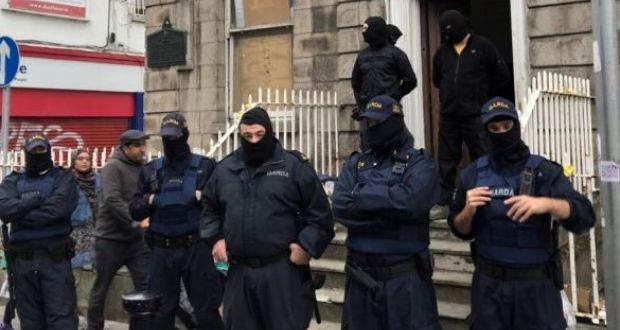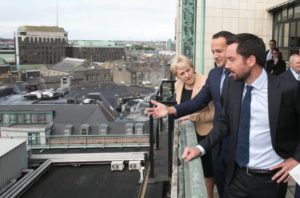
Home at last?

Trump. Putin. May. Al-Assad. Erdogan. Jong-un. Merkel. Enda. What a shower. What a gallery of rogues. Undistinguished blackguards one and all. But as bad as they are, and they’re pretty bad, they won’t rank as the worst collective of despots to have ever roamed the earth. Indeed, we’ve seen worse in our own lifetimes; Bush, Saddam, Gaddafi, Mugabe. And then there’s Margaret Thatcher, the Iron Lady herself, the most hated Prime Minister in Great Britain’s history, a woman whose death in 2013 saw street parties held all over the UK.
Although I lived in Thatcher’s England, and probably suffered from some of her policies, I was too young to fully understand the impact of her governance. For that I’ve had to rely on the stories of others, and upon television. Because in nineteen-eighties England the revolution was televised. Sure, there was still the usual airbrushed fodder, genteel comedies for those who liked to live in denial, but there was also tubthumping anarchism in the form of The Young Ones, Boys from the Blackstuff, Auf Wiedersehn Pet, Withnail and I, productions that sought to depict what life was really like under her stewardship.
And it was grim, really grim.
It was from programmes like this that I came to understand the meaning of the word ‘squatting’, i.e.; “the action of occupying an abandoned or unoccupied area of land or a building, usually residential, that the squatter does not own, rent or otherwise have lawful permission to use.”
From my bedroom in rural Ireland, this sounded like an awful business, something only the lowest of the low would do. And when naysayers referred to these squatters as scum, as scroungers, dole-heads and workshy crusties, I was inclined to agree.
But how one’s perspective can change.

And I can now see that the people depicted in those shows from the eighties weren’t scum at all. Because if they were, then so am I.
Thankfully, I’m not so far gone that I have to resort to squatting, but who knows what the future holds? Very few of us are safe from the rapacious needs of the private rental market, and fewer still can look forward to one day owning their own homes.
And so, it’s in this spirit that I look upon the actions of the ‘Take Back the City’ (TBTC) group, the Dublin-based organisation who ‘reclaim’ unoccupied private properties, with a degree of empathy. Sure, they’re breaking the law, but their reasons for doing so are just. By occupying these houses, inner-city residences which although vacant, aren’t being made available for rent, they are highlighting the inadequacies of the Irish property market; a system where profit is king, where those with capital can afford to hoard empty buildings and allow rents to rise for their own benefit, at the cost of everyone else.
The end-goal for TBTC, according to spokesperson, Aisling Bruen, is the compulsory purchase order of these properties, for the government to step in and take these buildings, to reclaim them from their owners for the purposes of the ailing rental sector. It is allowed to do this, it says so right there in the constitution. But the chances of it doing so, of resorting to such drastic measures, seem remote.
Lest we forget, this is a government which continues to cling desperately to the belief that the housing crisis will just sort itself out. That by cracking down on Airbnb, shifting the blame onto the councils and selling public lands to private developers. we will all somehow magically end up in our dream homes.
It says that it’s tackling the crisis, that it shares our frustration, and that more social houses have been built this year than last. But we’re talking ludicrously small figures here. There was 780 social houses built in 2017, and 247 built in 2016. These numbers are way down on the target outlined in the Rebuilding Ireland plan which predicted 13,189 new builds by 2020. That plan was painstakingly put together and presented to the public like a shiny new toy, its authors grinning for the cameras like proud parents, happy to take credit for something that hadn’t even happened.

And only 10 per cent (15,000) of these will be social houses, with a further 30 per cent (45,000) categorised as “affordable”. Even if those figures are met, it still won’t be anywhere near enough. And the 60 per cent, the vast bulk of these new builds? Well, they’ll be handed over to, you guessed it, private developers, funnelled back into the system by profiteering landlords, hoarders and multiple-property owners.
The sad fact is that despite all their plámásing, all their hand-wringing and earnest gestures, Leo and the boys just don’t get it. They don’t understand that for most people a council house is more than enough, that living in a housing estate is perfectly fine, that so long as these areas aren’t ghettoised, stigmatised so that those living in them are looking down upon by society as a whole, we’ll happily see out our days in a nondescript, mass-produced three-bed on the outskirts of town. They can’t for the life of them figure out why it should be up to them to provide homes for the people they represent, because to them a house is something you buy, something you sell, and something you buy again.
However, I’m inclined to believe that none of this really matters, that the inability of Eoghan Murphy to grasp the true cause of the housing crisis and Mr Varadkar’s firm adherence to his neoliberal roots, is swiftly becoming of secondary concern. Because with each passing day, as the numbers of people without homes continues to rise, this government adds another drop of ink to its death warrant.
Opinion polls suggest that support for Fine Gael remains strong, that it maintains a solid lead over Fianna Fáil, and that our Taoiseach continues to ride the groundswell of support which greeted his ascension.
But people will only take so much, only listen to so many excuses. And in displaying such blithe indifference to the most basic of human rights, in ignoring the needs of the plenty over the wants of the few, Leo Varadkar runs the risk of going down in history for all the wrong reasons.
The way to a man’s heart is through his nose

But while the bunny ears and blow-up dolls are amusing, the catcalls and innuendo terrifying, it’s the scent of these women which lingers longest. The perfumes and incense, aromas and fragrances, which follow their every move, hovering over them, around them, like a beautiful, sweet, sickly cloud.
Of course, we’re just as bad; I wouldn’t dream of entering a bar without at least a litre of Chanel Allure doused over every inch of my person. But scientists haven’t been analysing how we smell, at least not this week.
It’s you ladies who’ve been under the microscope, your pits that’ve been under scrutiny. And, according to boffins, the nicer you smell the more fertile you’re likely to be. But wait, this doesn’t mean you should buy that bottle of Daisy you’ve been hankering after, pour the whole lot over your head and wait for babies to start magically appearing all over the house.
No, this study was done on women who went au naturale, swabs taken from their underarms in the hours after they’d washed with odourless soap. These samples were then smelled by men and ranked in order of preference. The researchers found that the most popular smells were those taken from women whose hormones suggested high fertility and an ability to become pregnant.
Educational, I’m sure you’ll agree, but ultimately quite worthless.
For a start, we don’t go around sniffing women like dogs on heat, mounting the ones we deem worthy of our affection. We are a visual species. And also, no matter how good those pheromones smell, they’ll never be as appealing as Marc Jacobs’ latest, most expensive creation.










